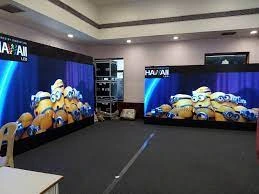Blog Details
led video wall in india

- Posted On 19 Mar 2022
#ledvideowallinindia #rentalLedscreenindia #advertisingleddisplayscreeninindia #ledscreenmanufacturers #Ledwallpriceinkerala #p2ledwallinindia #Leddancefloor #novastarvx1pricesinIndia #leddisplaymanufacturerinIndia
LED video walls are made up of Direct View LED displays (also known as DV) that work together as a single screen to display content. Because each component is responsible for transmitting and generating its own light, LED screens are extremely efficient.
LEDs (Light-Emitting Diodes) are a type of light-emitting
The term "light-emitting diode" refers to a two-lead semiconductor light source that is very small. LEDs are unique in that, unlike any other digital signage technology, they can produce and emit light on their own. As a result, they are incredibly long-lasting and durable.
Light-emitting diodes (LEDs) are little light bulbs that can be plugged into an electrical circuit. They do not, however, have a filament like normal light bulbs. As a result, they don't burn out or get too hot. Only the mobility of electrons in a semiconductor substance illuminates them. The hue of the bulb is also determined by this. Unlike other video walls, which use backlighting, LEDs actually create the visuals.
The pixel density of LEDs is rapidly improving as the market for LEDs develops. The chasm that once separated LED and LCD is rapidly shrinking.
LEDs used in video walls are unique in that they can display "true black." Each LED is coated with black resin epoxy to achieve this. To isolate the illuminations and eliminate reflection, shades are fitted between the lights.
Mounting
Dv LED video walls are made up of a number of miniature LED displays that are installed on a flat screen. As a result, when establishing an LED video wall, it's crucial to keep the average viewing distance in mind. The resolution will be determined by the number of pixels in this scenario. The finer the pixel pitch required, the closer people are to the led video wall.
One surface mount device equals one pixel in an LED video wall (SMD). The RGB die is located on that little pixel. The pitch is used to compute the pixel density. The distance (in mm) between each SMD LED determines the pitch.
LED Digital Signage's Advantages
LED lighting would not have been a viable option for most business owners a decade ago.
As the market increases, it is progressively becoming the most formidable competitor to LCD.
Installing an LED video wall has an infinite amount of advantages.
Here are a few examples of what you may expect from this type of technology: Lighting:
800 nits of high brightness
High-intensity illumination
It can be shown in a well-lit room or on a showroom floor.
Outdoor video video walls are ideal.
When compared to LCD, it handles ambient illumination better.
It's powered by NIT, not Lux.
Reliability:
Long-lasting and energy-efficient
50,000 hours of life expectancy
Any video wall on the market has the best refresh rates.
Installation:
LED panels feature small bezels (seams) and can be tiled together to provide a seamless look.
Pixel density is lower.
Unparalleled consistency
Viewing angles are broad.
Depth varies, with rear access being the most typical.
Any size or form is acceptable, not just 16:9.
Quality:
With epoxy coated LEDs, pure black is achieved.
95 percent NTSC colour gamut and precision
Source of self-emitting light
For the high-impact graphics that a led video wall installation necessitates, LED is a very efficient application. The picture is clear, the integration is adaptable, and the hardware is more cost-effective than ever before. LEDs have gone a long way in the previous ten years, and if they continue to improve, they will be the most common digital signage hardware on the market.
LED video walls are made up of Direct View LED displays (also known as DV) that work together as a single screen to display content. Because each component is responsible for transmitting and generating its own light, LED screens are extremely efficient.
LEDs (Light-Emitting Diodes) are a type of light-emitting
The term "light-emitting diode" refers to a two-lead semiconductor light source that is very small. LEDs are unique in that, unlike any other digital signage technology, they can produce and emit light on their own. As a result, they are incredibly long-lasting and durable.
Light-emitting diodes (LEDs) are little light bulbs that can be plugged into an electrical circuit. They do not, however, have a filament like normal light bulbs. As a result, they don't burn out or get too hot. Only the mobility of electrons in a semiconductor substance illuminates them. The hue of the bulb is also determined by this. Unlike other video walls, which use backlighting, LEDs actually create the visuals.
The pixel density of LEDs is rapidly improving as the market for LEDs develops. The chasm that once separated LED and LCD is rapidly shrinking.
LEDs used in video walls are unique in that they can display "true black." Each LED is coated with black resin epoxy to achieve this. To isolate the illuminations and eliminate reflection, shades are fitted between the lights.
